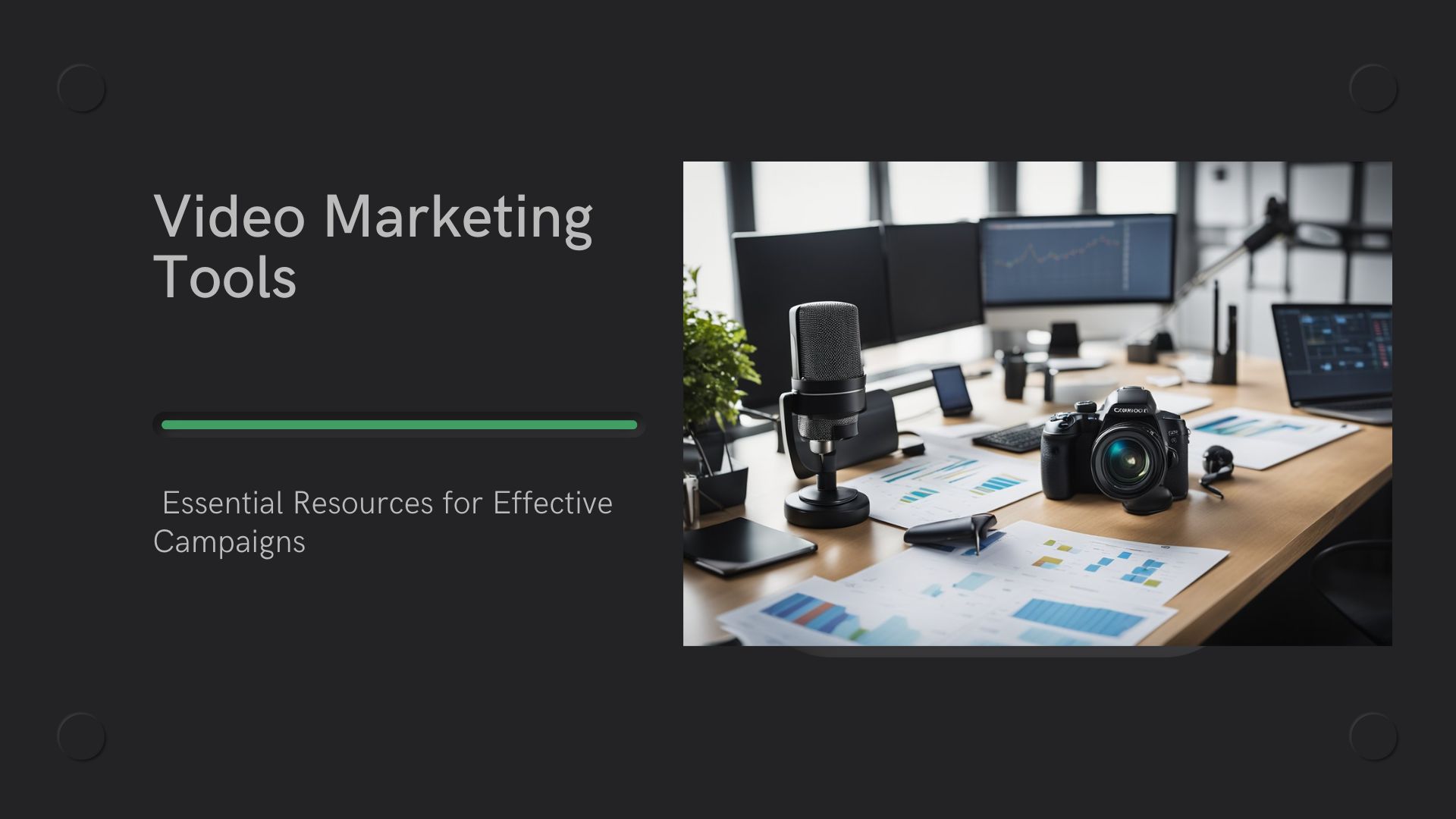As I dive into the world of video marketing, I find that choosing the right tools can make a significant difference in the success of my campaigns.
From creating engaging videos to analyzing their performance, these tools are essential for any marketer looking to enhance their strategy.
Video marketing tools can streamline the process of production, distribution, and analytics, ensuring that I get the best return on my investment.

In my experience, the best video marketing tools cater to diverse needs, whether a business is looking for simple editing options or comprehensive analytics.
Platforms range from hosting services to all-in-one solutions that simplify workflows.
With tools like Vidyard and ClickUp, I can easily manage my content and track how well it resonates with my audience.
The future of video marketing looks bright as these tools continue to evolve.
With new features coming out regularly, I am excited to explore what these innovations will bring to my marketing efforts.
By leveraging the latest technology, I can stay ahead in a competitive landscape and connect more effectively with my audience.
Table of Contents
Understanding Video Marketing
Video marketing has found its place as a powerful tool in today’s advertising landscape. I’ll explore how it evolved and why it matters so much now.
Evolution of Video Marketing
Video marketing has come a long way since its inception.
Initially used mainly for TV commercials, it has transitioned into online platforms. The rise of social media has played a key role in this shift.
Today, I see videos on sites like YouTube, Instagram, and TikTok, making them accessible to wider audiences.
This evolution has prompted the rise of various video marketing tools that help create and share impactful content efficiently.
Tools like Animoto and Canva simplify video creation. They provide templates and editing options, making it easier for anyone to produce quality videos.
These advancements allow marketers to adapt quickly to trends and engage consumers effectively.
Significance in Modern Advertising
Video marketing is crucial for businesses today. With 91% of marketers using it, I understand its ability to drive traffic and increase sales.
According to recent statistics, viewers retain 95% of a message when it’s delivered via video.
This high retention rate underscores the need for effective video content.
Platforms like Adobe Premiere Pro and Final Cut Pro offer powerful editing tools for professionals. They help to enhance video quality and storytelling.
Moreover, video’s shareability on social media increases brand exposure.
Creative videos can easily go viral, expanding audience reach in ways text alone cannot achieve.
Investing in the right video marketing tools is essential for success in this competitive environment.
Strategic Planning for Video Campaigns

Effective video campaigns start with solid strategic planning. I focus on defining clear objectives and understanding the target audience to ensure the content resonates well and meets specific goals.
Defining Campaign Objectives
I begin by setting specific objectives for the video campaign.
This might include increasing brand awareness, generating leads, or boosting sales. Each objective should be measurable so I can track progress.
For example, if my goal is to increase website traffic, I might aim for a specific number of views or click-through rates.
Using tools like Google Analytics helps me assess whether I’m meeting my goals.
I also prioritize aligning these objectives with my business goals. This ensures that each video contributes to the larger marketing strategy.
Target Audience Analysis
Understanding my audience is crucial to my video campaign’s success.
I analyze their demographics, preferences, and viewing habits. This helps me create content that appeals directly to them.
I often start by creating audience personas. These personas summarize key traits, such as age, interests, and challenges. This information guides my content’s tone and style.
I also consider where my audience consumes video content.
Are they on social media, websites, or YouTube? This helps me choose the right platforms for distribution.
Knowing my audience enables me to tailor videos that not only capture attention but also drive action.
Creating Compelling Video Content
Crafting engaging video content requires a clear narrative and strong visual branding. I focus on storytelling and aesthetics to capture attention and maintain viewer interest.
Storytelling and Scriptwriting
Effective storytelling is at the heart of video marketing.
I begin by defining the core message I want to communicate. A good story follows a structure: introduction, conflict, and resolution. This keeps the audience engaged.
I also invest time in scriptwriting.
A well-crafted script includes clear dialogue and direction. Using video marketing tools like WriterDuet helps me with real-time collaboration and professional formatting.
Additionally, I ensure that my script aligns with the emotions I want to evoke, whether that’s excitement, empathy, or curiosity.
Another key aspect is knowing my audience.
I tailor stories to their preferences and behaviors. This personalization makes the content relatable and memorable.
Branding and Aesthetic Choices
Visual branding plays a crucial role in how viewers perceive my content.
I select colors, fonts, and styles that reflect my brand identity. Consistency in these elements strengthens recognition.
In terms of aesthetics, I use Vidyard to organize and host my videos, creating a unified look.
High-quality visuals and sound are essential. I pay attention to lighting and equipment used during filming to enhance professional appeal.
Animation and graphic elements can further elevate my videos. They add depth and help illustrate key points.
By maintaining a strong branding strategy, I ensure that my videos not only tell a story but also reinforce the brand’s image in the viewer’s mind.
Video Production Tools
When creating engaging videos, the right tools are essential. I focus on high-quality camera and filming equipment, along with powerful editing software to produce effective video content.
Camera and Filming Equipment
The foundation of any video project is quality camera equipment.
I prefer DSLR or mirrorless cameras for their versatility and image quality. Brands like Canon and Sony offer excellent options.
Key equipment includes:
- Camera Body: Look for options with 4K capability.
- Lenses: A range of lenses can provide different looks. I often use a standard zoom lens for flexibility.
- Tripods/Stabilizers: To ensure steady shots, a sturdy tripod or gimbal stabilizer is crucial.
- Lighting: Good lighting can enhance video quality. Softbox lights or LED panels work well.
Investing in these tools can elevate the visual appeal of my videos significantly.
Editing Software
Editing software is where I bring my vision to life. It’s essential for cutting footage and adding effects.
I often use programs like Adobe Premiere Pro or Final Cut Pro due to their extensive features.
Important features to consider:
- User-Friendly Interface: This makes navigation easier.
- Multi-Track Editing: It allows me to layer audio and video seamlessly.
- Color Correction Tools: These are vital for adjusting the look and feel of the video.
- Export Options: Ensure compatibility with various platforms.
Choosing the right editing software helps me create polished, professional videos that capture attention.
Analytics and Performance Tracking
Analytics and performance tracking are essential for understanding how well my video marketing efforts are working. By focusing on measuring audience engagement and tracking conversions, I can make informed decisions that enhance my strategy.
Measuring Engagement
To gauge how my videos resonate with viewers, I look at key engagement metrics.
This includes views, watch time, average view duration, and likes or shares. High engagement indicates that my content captivates the audience, while low metrics signal the need for improvement.
I often use tools like VIDIQ to access real-time data on these metrics.
This tool helps me analyze viewer behavior and find the best content topics. Understanding audience retention helps me tailor my videos to keep viewers interested and increase the likelihood of sharing.
Conversion Tracking
Tracking conversions is crucial for measuring the effectiveness of my video marketing.
I want to know how many viewers take specific actions after watching my videos, such as signing up for a newsletter or making a purchase.
Using tools like Google Analytics, I can monitor these actions.
I set up goals to track conversions directly tied to my video content, making it easier to see which videos drive the most results.
By combining this data, I can optimize future video campaigns to boost conversion rates and achieve my marketing goals.
Distribution Platforms

In today’s digital landscape, choosing the right distribution platforms is crucial for effective video marketing. This section will cover key social media channels and video hosting services that can enhance your marketing strategy.
Social Media Channels
Social media channels like Instagram and TikTok are vital for video marketing.
Instagram is ideal for shareable content, with features like Stories and Reels that promote engagement. I can tailor educational and entertaining videos to fit these formats.
TikTok is another powerful platform.
With around 750 million monthly users, it focuses on short-form, creative videos. The audience is younger, making it important for brands targeting this demographic. I can create catchy, fun content that resonates with users.
To maximize reach, I must consider each platform’s unique features, such as TikTok’s trending challenges or Instagram’s shopping capabilities.
Video Hosting Services
Video hosting services play a significant role in ensuring my videos are easily accessible.
Platforms like YouTube are essential for long-form content. I can leverage its vast audience to gain visibility.
Vimeo offers high-quality video hosting with customization options. This is useful for branding and presents a professional image. I can also use tools for video analytics to track performance.
When choosing a service, I analyze features like storage limits, embedded player options, and monetization capabilities.
Each service has its strengths, allowing me to amplify my video marketing efforts.
Optimizing for Search Engines
To enhance the visibility of my videos in search results, I focus on effective optimization strategies.
This involves using SEO best practices tailored for video content and properly utilizing metadata to convey important information about the videos.
SEO Best Practices for Videos
When optimizing my videos, I prioritize several best practices.
First, I ensure that my video title is clear, engaging, and contains relevant keywords. This helps search engines understand what my video is about.
Next, I create compelling thumbnails. A high-quality thumbnail often attracts more clicks, improving my video’s ranking. I also keep my video descriptions concise yet informative, summarizing key points with relevant keywords woven throughout.
Additionally, I consider video length. Shorter videos tend to perform better, but I ensure mine are long enough to provide value. Engaging with viewers through comments also boosts my SEO, as interaction signals content relevance.
Utilizing Metadata
Metadata plays a crucial role in video optimization.
After uploading my video, I focus on adding accurate metadata to the title, description, and tags. This metadata communicates the video’s content to search engines effectively.
I pay attention to the description. It should summarize the video and include important keywords. Tags help categorize my video, making it easier for viewers to find it through searches.
I make sure to include a transcript of my video when possible. This text aids search engines in indexing the video and improves accessibility for viewers. Utilizing tools that analyze video performance helps me refine these elements over time.
Maximizing Outreach
I believe that effectively using video can significantly enhance outreach efforts.
By incorporating video into email marketing and employing cross-promotion strategies, I can engage my audience more effectively.
Incorporating Video in Email Marketing
Using video in email marketing can dramatically increase engagement rates.
I can embed videos directly into my emails or use enticing thumbnails that link to the video hosted on a platform like YouTube or Vimeo.
Key Tips:
- Use a compelling subject line: This captures attention immediately.
- Add a clear call-to-action (CTA): Encourage recipients to click through and view the video.
- Optimize for mobile: Many people check emails on their phones, so ensuring videos work well on mobile devices is crucial.
Research shows that including videos in emails can lead to a 200-300% increase in click-through rates. This simple addition can make my messages more memorable and engaging.
Cross-Promotion Strategies
Cross-promotion involves sharing my video content across multiple platforms to reach a broader audience.
I can leverage social media, blogs, and even partnerships with other brands or influencers for effective cross-promotion.
Key Considerations:
- Share on multiple channels: Post videos on platforms like Facebook, Instagram, and LinkedIn to maximize visibility.
- Utilize hashtags: These can boost reach and engagement on social media.
- Engage with comments: Responding to viewer comments helps build community and encourages further interaction.
I can also repurpose video content for different formats, like snippets for Instagram Stories or blog posts summarizing the video’s content. Using a variety of platforms ensures my message reaches diverse audiences, enhancing my outreach efforts.
Monetization Strategies
In my experience with video marketing tools, I’ve found various monetization strategies effective for content creators. Here are the main ones I consider:
- Subscription Video on Demand (SVOD): Users pay a recurring fee for access to a library of content. This model provides steady income.
- Transactional Video on Demand (TVOD): I can sell individual videos or rentals. This is great for specialty content that viewers might not want to buy outright.
- Advertising Revenue Sharing: Platforms like YouTube allow me to earn money through ads. I create engaging content, and ads generate revenue.
- Sponsorships: Collaborating with brands can provide significant income. I integrate their products or services into my videos in exchange for payment.
- Crowdfunding: I can ask my audience to support my projects through platforms like Patreon. This creates a direct connection with my viewers.
Here’s a quick comparison:
| Strategy | Description | Pros |
|---|---|---|
| SVOD | Monthly subscriptions | Predictable income |
| TVOD | Pay-per-view or rental | High earnings on popular content |
| Ad Revenue | Earnings from ads | Low effort to maintain |
| Sponsorships | Brand collaborations | Potentially high income |
| Crowdfunding | Audience support through donations | Direct connection with fans |
Exploring these options will help me find the best fit for my content and audience. Each strategy has its benefits, so I carefully consider what aligns with my goals.
Emerging Trends in Video Marketing

Video marketing is evolving rapidly. I see two key trends that are shaping the future: interactive and shoppable videos, along with advancements in augmented reality (AR) and virtual reality (VR). These trends offer exciting opportunities for brands to engage with their audiences in new and meaningful ways.
Interactive and Shoppable Videos
Interactive videos allow viewers to engage directly with the content. They can choose story paths, answer questions, and make decisions that shape their viewing experience. This level of engagement keeps the viewer’s attention longer and creates a more memorable experience.
Shoppable videos take this a step further. They allow users to click on products or links directly from the video. This feature streamlines the shopping experience and can increase conversions significantly. For example, a video that shows a fashion item can include links to buy it immediately. This direct approach is beneficial for both brands and customers, as it makes shopping easier and more enjoyable.
Advancements in AR and VR
AR and VR technologies are transforming how brands approach video marketing.
I find that these tools create immersive experiences that capture attention and enhance storytelling.
For instance, AR can be used to overlay digital information in real time, allowing consumers to visualize products in their own space.
VR, on the other hand, provides a fully immersive experience that can transport viewers to different environments.
This technology is particularly effective for industries like travel and real estate, where I can offer virtual tours that engage potential customers.
Both AR and VR encourage deeper connections with the audience and make video content more interactive.
FAQs:
What are video marketing tools?
Video marketing tools are software or platforms designed to help businesses create, edit, optimize, and analyze video content for marketing campaigns. These tools streamline video production and enhance the effectiveness of marketing strategies.
Why are video marketing tools essential for businesses?
Video marketing tools simplify content creation, improve audience engagement, and provide analytics to measure campaign success. They help businesses stand out in competitive markets by delivering high-quality video content.
What features should I look for in video marketing tools?
Key features to look for in video marketing tools include video editing capabilities, analytics and reporting, social media integration, and customizable templates. Choose tools that match your campaign goals and technical expertise.
Are there free video marketing tools available?
Yes, many free video marketing tools are available, such as Canva for basic editing or Clipchamp for quick video creation. However, premium tools often offer advanced features like detailed analytics and automation.
How do video marketing tools improve campaign performance?
Video marketing tools improve campaign performance by enabling the creation of professional-quality videos, optimizing content for specific platforms, and providing insights through performance analytics. This ensures your video content resonates with your target audience.




